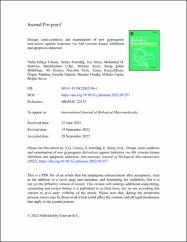Design, semi-synthesis and examination of new gypsogenin derivatives against leukemia via Abl tyrosine kinase inhibition and apoptosis induction

View/
Access
info:eu-repo/semantics/embargoedAccessDate
01.10.2022Author
Ulusoy, Nafia GökçeEmirdağ, Safiye
Sözer, Ece
Radwan, Mohamed O.
Çiftçi, Halil İbrahim
Aksel, Mehran
Şahin Bölükbaşı, Serap
Özmen, Ali
Yaylı, Nurettin
Karayıldırım, Tamer
Alankuş, Özgen
Tateishi, Hiroshi
Otsuka, Masami
Fujita, Mikako
Sever, Belgin
Metadata
Show full item recordCitation
Ulusoy, N. G., Emirdağ, S., Sözer, E., Radwan, M. O., Çiftçi, H., Aksel, M., ... & Sever, B. (2022). Design, semi-synthesis and examination of new gypsogenin derivatives against leukemia via Abl tyrosine kinase inhibition and apoptosis induction. International Journal of Biological Macromolecules.Abstract
Chronic myelogenous leukemia (CML) is characterized by Philadelphia translocation arising from Bcr-Abl fusion gene, which encodes abnormal oncoprotein showing tyrosine kinase (TK) function. Certain mutations in kinase domain, off-target effects and resistance problems of current TK inhibitors require the discovery of novel Abl TK inhibitors. For this purpose, herein, we synthesized new gypsogenin derivatives (6a-l) and evaluated their anticancer effects towards CML cells along with healthy cell line and different leukemic cells. Among these compounds, compound 6l was found as the most active anti-leukemic agent against K562 CML cells compared to imatinib exerting less cytotoxicity towards PBMCs (healthy). This compound also revealed significant anti-leukemic effects against Jurkat cell line. Besides, compound 6l enhanced apoptosis in CML cells with 52.4 % when compared with imatinib (61.8 %) and inhibited Abl TK significantly with an IC50 value of 13.04 ± 2.48 μM in a large panel of kinases accentuating Abl TK-mediated apoptosis of compound 6l in CML cells. Molecular docking outcomes showed that compound 6l formed mainly crucial interactions in the ATP-binding cleft of Abl TK similar to that of imatinib. Ultimately, in silico pharmacokinetic evaluation of compound 6l indicated that this compound was endowed with anti-leukemic drug candidate features.















